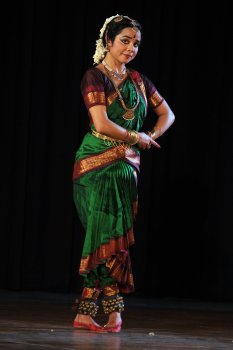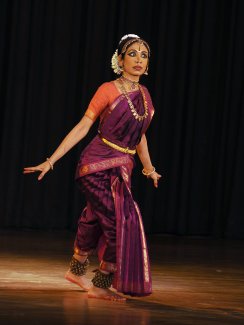
|   |

|   |
Madras Music Academy dance festival: Day 3 - Veejay Sai e-mail: vs.veejaysai@gmail.com Photos courtesy: Madras Music Academy January 13, 2013 Slow motion queen  At the inaugural ceremony, they had announced that a fair number of NRI’s were given chance to perform this season. The first on the list this time was Malini Srinivasan based out of New York. A student of Guru CV Chandrasekhar, Malini had her arangetram in 2003 according to the bio given by the academy. The third morning show began with some excellent vocals by K Hariprasad. Malini began her performance with a Jatiswaram in ragam Shankarabharanam set to misra chapu talam, a composition of the Thanjavur quartet. Malini has a pleasant demeanor on stage but there ended the fairy tale. The high energy Jatiswaram was drastically slowed down by the choreography. As Malini moved in ultra slow motion, one wondered where the energy of the youngster vanished. With such an opening, everyone sat back in their seats not knowing what to expect next. However Malini seemed to be in a good hurry to make an exit and rushed out of the stage faster than she performed her Jatiswaram. Malini presented the Varnam ‘Swami naan undan adimai,’ a composition of Papanasam Sivan in ragam Natukurinji set to adi talam. While everyone knows this classic Varnam that has been performed often, what marked or rather marred Malini’s presentation was the slow jathis. The second half of the Varnam that began at ‘Nataraja deva’ had her guru CV Chandrashekar on the nattuvangam on high speed. In spite of accelerated effort, Malini slowed down the rest of the Varnam. By now she seemed to be at a good ease with the slow motion she was performing all along the way. The third piece ‘Shyam tori,’ a Surdas bhajan opened with Adyar Muthukumar’s melodious flute in ragam Shivaranjani. Malini announced that she learnt this piece at a workshop that Leela Samson took. She also announced that all the students at the workshop were told to use their imagination and put the choreography together. Going by that, one could see that what could have otherwise been a brilliant piece of choreography turned out to be tedious. Due to time constraint Malini had to cut short her performance and did not present two of the listed items from her show. If only she had been a bit more active, she would have managed to accommodate those two as well. A highly capable dancer, Malini needs to get her act together. The issue was not the tissue  Vidhya Subramanian is not a new face in the dance circuit. A student of Vaadhyaar Swamimalai Rajarathnam Pillai and Kalanidhi maami, Vidhya beats several people in her age group with drop dead gorgeous looks. If looks were everything, Vidhya would have ruled the roost. Unfortunately that not being the case, she presented an average performance for a mid-morning slot. Opening with the well known ‘Shambhu Narthanam’ composed by Pathanjali, the father of the Yogasutras, Vidhya’s dance seemed to be like a forced effort without any natural ability to exhibit her style and idiom. After a melodious aalapam in ragam Shankarabharanam by Kalaiarasan on the violin, Vidhya continued into ‘Sakhi ye’, a Varnam by K N Dhandayudhapani Pillai. Vidhya seemed totally distracted in her presentation. While describing her sancharis about Garuda, one could see how briskly the eagle flapped its wings but suddenly decided to take off in a slow motion. Her depiction of Lord Vishnu’s Shankhu and Chakram to Muthukumar Balakrishnan’s flute was noteworthy, but with her involvement into the characters and story being rather cursory, the whole presentation came across as superficial. Having a good voice does not necessary equal having good singing. This fact came forth in Asha Ramesh’s rendering of Jayadeva ashtapadi ‘Yahi Madhava.’ Asha kept shouting “Yaheeeeeeeeee!” into the mic not knowing how awkward it was sounding to the composition and to the mood of the song. Lord Krishna himself would have run away with that kind of unnecessary shouting added to bad Sanskrit. Singers need to know where to stress and on what syllables, especially in a sensitive language like Sanskrit. A Javali ‘Meregadu’ in Telugu turned out to be nightmarish for everyone including the dancer. Added to this, Vidhya who had gone into the wings in the brief interval before the Javali, dabbed her face hard with a tissue paper. How would we know that? Well, she came out and danced to the Javali with patches of tissue paper stuck to her face and that was enough to distract everyone for the rest of her show. At some point, only god knows what happened and the Javali was cut short abruptly with Vidhya whispering something to her singer and the show ended with a Thillana composed by Dr. Mangalampalli Balamurali Krishna in ragam Kuntalavarali which the singer tried hard to imitate the maestro in his style of rendering. Dancers must take caution, especially with Thillanas composed by Dr. BMK as not all of them necessarily suit dance. Most of them sound excellent purely for kutcheri purposes. Vidhya got back to being lively except her abhinaya for the wordings of the Thillana didn’t make sense. She depicted herself playing tambura for the phrase ‘Kuntalavarali thillana’ which seemed totally disconnected. Having learnt dance from such great gurus, why was Vidhya so half-hearted in her presentation? Old might indeed be gold  What does one write about the biggest diva of Bharatanatyam dance? After the release of her documentary ‘Lasya Kavya’ won the national award, one hasn’t seen Valli perform so often. But whenever she did, it was a sheer pleasure to watch her perform some of the timeless classics in the Bharatanatyam repertoire. Whatever critics say or other dancers gossip, Alarmel Valli and Malavika Sarukkai have been consistent about being brilliant with their work and promoting the dance form to global audiences. As expected, the academy’s performance had a packed hall. Valli dedicated her performance to the late Shobhana Swamy, her nattuvanar and artistic collaborator for many decades. Valli began with an ode to love titled ‘Rati Sukha Saare’ composed in a Ragamalika by Rajkumar Bharathi and set to rupaka talam. In this, verses from medieval Sanskrit poetry - from Bhoja’s Sringara Prakasanam and Kalidasa’s Ritusamharam - were strung together and choreographed with the concept and idea to celebrate love and nature. King Bhoja extols the supremacy of the shringara rasa saying: Scholars mention ten rasas, but we declare that shringaram is supreme, most savored amongst the rasas. Spring, the season of love is glowingly depicted in verses from Kalidasa’s Vasanta Ritu, which evoke the atmospherics of love. The composition concludes with a benediction invoking Manmatha, the God of Love saying, “May the god of love, the bodiless one, attended by his close companion, spring, shower bountiful blessings of happiness and love upon you.” What a wonderfully different beginning to the evening! In the second piece, a Varnam composed by Prema Ramamoorthy and Valli titled ‘Kaana Aavalanen’ set to Ragamalika in rupaka talam was in praise of Lord Nataraja. The heroine spoke of her love for the lord and tells her friend that she yearns for a glimpse of her beloved - the peerless Lord of Dance. The devotee's devotion and rapture on seeing Chidambaram was well-portrayed in the line ‘Needhi nilavum Thillai ambalam tanil aadum Chidambara naadanai.’ The construction of the Chidambaram temple in her sancharis to the melody of ragam Charukeshi was excellent. In her clever interpretation of the line, ‘Paravasamigum vasanthamidil mohalahiri meerude,’ Valli continued to depict the central motif of the earlier invocation - of spring as a harbinger of love. What is an Alarmel Valli performance without the touch of Sangam poetry in it? It continues to be an integral part of each and every show of hers. Dancers like Valli have done much to make Sangam poems so popular among the dance lovers. Else they would have remained in literary circles or in the dusty shelves of libraries. The third item Valli presented was a clever juxtaposition of two compositions. The first one ‘Sirai Pani’ from ‘Kuruntogai’ was set to ragam Shivaranjani and adi talam by Prema Ramamoorthy. The mood of this poem was one of bleakness and desolation. The setting was that of a cold winter's night that evoked the mood. A contrast to this mood was the second piece ‘Muttavaddura.’ This Javali in ragam Saveri composed by the Thanjavur quartet is the tale of a bitter and angry nayika who berates her lover for his philandering ways. The rasikas got a taste of some excellent and contrasting abhinaya in both these pieces. Valli concluded her performance with a ‘Nrittalahari’ composed in ragam Abhogi and adi talam by Prema Ramamoorthy. C K Vasudevan was excellent on the nattuvangam in the true Pandanallur style while Nandini Anand Sharma’s voice was at its emotive best. And what can one say of Shruti Sagar’s flute? Rasikas, dancers and every other dance lover is slowly getting addicted to his melodious flute, season after season. Valli’s dance reiterated the fact that old was still gold in many ways. Spinning and grinning end to end  The final show of the third day was a Kathak group performance by Abhimanyu Lal and Vidha Lal group. The son and daughter-in-law of veteran Kathak dancer Gitanjali Lal gave the Music Academy a good taste of their Kathak but very less of the Jaipur Gharana style. After a brief invocatory piece, the duo performed ‘Andaaz –e-raqz’, a pure dance sequence set to teen taal or the sixteen beat cycle. While this particular composition exhibited each of their footwork and mastery over their tatkaar, it was not necessarily the traditional Jaipur Gharana they hailed from. Except for the tabla’s intervention with a few bols, most of it was hardly recognizable from the Jaipur repertoire. “Why does he have a tilak while she is bare on her forehead?” asked a curious rasika loudly, noting the visible difference in their aaharya. The Jaipuriyas are known for their temple traditions and their dance costumes often reflect their roots unlike the Gharanedaars from Lucknow. Hopefully the next time Vidha would take this significant point into consideration. They presented several ‘Padhanths’ and a particularly attractive one was where the beat went in the descending progression of a cow’s tail. In the sequences where there was a dialogue between the dancer’s footwork and the tabla, Abhimanyu was highly impressive. “Spinning is my forte!” announced Vidha into the mic, as she continued to tell everyone about her world-record-winning 103 chakkars in one minute. In ‘Varsha Mangal’ set to Sur Malhaar and teen taal, the duo portrayed the beauty of monsoons. However the singing of Amjad Ali got a bit drowned out with the loud percussion at various important junctions within the item. Following that Vidha presented ‘Yahi Madhava’, a famous Jayadeva ashtapadi set to raag Malkauns. While Vidha’s abhinaya was good in patches, the mispronunciation of the immortal Sanskrit song by Amjad Ali bothered everyone in the hall. Why don’t singers ever get the pronunciation right, especially of such time-tested classics on the stage? Abhimanyu continued into the next piece ‘Draupadi Cheer Haran’, depicting the famous incident from the Mahabharata. It was refreshing to see yet another interpretation of the episode by Abhimanyu. In many ways Abhimanyu out-did Vidha and proved to be far better in his abhinaya, in an inevitable comparison. Grinning and smiling at the audience time and again, both of them presented a good show overall. They ended their performance with a Tarana in which their group joined them. While their performance got huge applause, it would have been better if they had given the audiences a taste of the Jaipur Gharana’s rich heritage in Kathak. Veejay sai is a writer, editor and a culture critic. |